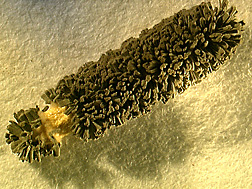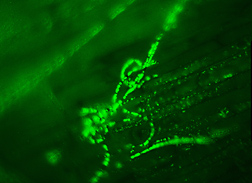Beeting Back the Enemy
A chemical-free way to guard sugar beets against a vile pest
In his eastern Montana laboratory, Stefan Jaronski is focused on a cluster of green-glowing strands crisscrossing under his microscope. He’s especially intrigued by the corkscrewing ones that appear to be choking off neighboring threads, like exotic vines spiraling around a tree.
Jaronski’s subjects are dozens of soil fungi and bacteria—some of which he’s endowed with a fluorescent protein from jellyfish so that they’ll be easy to spot. Certain ones appear fairly passive, content to just hang out. Others reach out with armlike hyphae to rob a neighbor of its food. Even on this minute scale, the world is a cutthroat place.
An insect pathologist with the Agricultural Research Service, Jaronski is studying these minute interactions to find out who’s most compatible. Which fungi and bacteria in the bunch are aggressors? Which are overly passive and vulnerable?
Just how these microbes mingle is significant because it helps Jaronski—who works at the agency’s Northern Plains Agricultural Research Laboratory in Sidney—determine which of his top-performing fungi are best suited for the task at hand.
His challenge? Finding an all-natural way to protect sugar beets from a costly enemy in the soil. Beets supply the country with half its refined sugar, but more than 40 percent of U.S. fields planted with these sucrose-storing roots are plagued with a vile underground pest: the sugar beet root maggot.
|
|
A Tiny Terror: Tetanops
The root maggot is the wriggling, immature form of the tiny fly Tetanops myopaeformis. It lurks in the soil, gnawing on young sugar beet roots. This scarring weakens or kills the plants by exposing their tender tissues to disease-causing pathogens. The maggot’s destructive feeding habits make it the most important pest on the 1.4 million acres of sugar beets grown in the western United States.
Up to now, farmers have kept the maggots at bay by using a cocktail of insecticides. “In 2001, about half of U.S. sugar beet acres were treated with chemical insecticides to control this insect,” says Jaronski. Because of the chemicals’ potential toxicity, farm workers must be specially certified to apply them.
Jaronski thinks there are viable pesticide alternatives to be found in nature. “The soil is already chock-full of organisms ready to parasitize each other for food and survival.” He’d like to take advantage of this rife competition by pitting one enemy against another. But which is the most potent against the root maggot? And which has the best chance of surviving in the microbial mix that makes up soil?
A Fungus That Fits In
The beneficial fungi that Jaronski is most interested in for the job are strains of Metarhizium anisopliae. Found all over the world, these soil dwellers are natural enemies of many insects.
“I like to think of Metarhizium fungi as the fatal ‘athlete’s foot’ of insects,” Jaronski explains. “Its spores are like those of bread molds and will germinate when they land on the surface of an insect.” In about 24 hours, the spores penetrate the insect’s skin, flourishing inside their host until they finally overwhelm it.
Jaronski wants to introduce these helpful fungi into beet fields suffering from maggot infestations. But for his plan to work, the fungi must be able to stand up to hundreds of other fungi and bacteria already residing in the soil.
Cindy Fuller-Schaefer, an ARS postdoctoral associate working with Jaronski, knows just how dynamic the world of soil fungi and bacteria can be. She worked for 9 months to make Metarhizium the “glow-in-the-dark fungi” that she and Jaronski could study easily.
She’s watched them interact with other microorganisms that inhabit sugar beet roots—and it isn’t always pretty. “If a fungus tries to invade a microbe’s space, the microbe makes toxins to defend itself—and vice versa,” says Fuller-Schaefer. “Fungi and bacteria can also exclude a competitor by stealing its nutrients. It’s basically biological warfare.”
In addition to surviving attacks from soil microbes, a fungus used as a natural control agent will need to take well to its sugar beet root environment. Just how vigorously the fungus grows and establishes itself determines how strong a barrier it will make.
The Most Promising Candidate
Currently Jaronski is focused on a Metarhizium strain called “F52.” It’s already registered in the United States for use against other insects, and it can be easily mass-produced, unlike other beneficial fungi.
“It’s important to select the right Metarhizium strain,” he says. “There are not only differences in the vulnerability of various fungi species to various soil microbes, but also in sensitivity among strains of the same species.”
But so far, F52 is still the leading candidate, having passed all Jaronski’s critical tests. “It looks like only a few soil bacteria can really affect its ability to grow,” he says.
Field trials in Sidney since 2001 have shown that Metarhizium is capable of controlling the pesky maggot. The fungus’s natural inhibiting abilities, Jaronski says, can be equal to the effectiveness of a powerful commercial insecticide.
Jaronski foresees delivering the fungus to fields in a granular form at the time of sugar beet planting. That way, it could colonize young plant roots and build up a protective barrier that incoming maggots couldn’t penetrate.
He’s also exploring a two-pronged biological control package for especially intense maggot infestations. “When maggots reach biblical proportions,” says Jaronski, “as they’ve been known to do in northeastern North Dakota, a single approach is insufficient.”
Along with collaborator Mark Boetel at North Dakota State University in Fargo, he’s found that integrating Metarhizium with a small-grain cover crop—such as rye or oats—increases the fungus’s effectiveness. The cover crop’s dense, leafy foliage confuses the female Tetanops fly when she’s searching for a place to lay her eggs. Plus, it provides a much-needed windbreak for young, struggling sugar beets.
Once he fully understands Metarhizium’s capacity to attack maggots and colonize sugar beet roots, Jaronski will focus on how to bond its spores onto a typical commercial seed.—By Erin K. Peabody, Agricultural Research Service Information Staff.
This research is part of Crop Protection and Quarantine, an ARS National Program (#304) described on the World Wide Web at www.nps.ars.usda.gov.
Stefan T. Jaronski is in the USDA-ARS Pest Management Research Unit, Northern Plains Agricultural Research Laboratory, 1500 North Central Ave., Sidney, MT 59270; phone (406) 433-9486, fax (406) 433-5038.
"Beeting Back the Enemy" was published in the September 2006 issue of Agricultural Research magazine.










